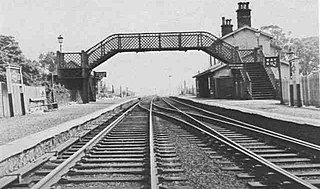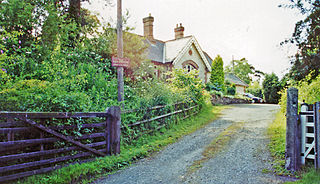Related Research Articles

Ashchurch for Tewkesbury is a railway station serving the North Gloucestershire and South Worcestershire Area from the outskirts of Tewkesbury in Gloucestershire, England. The station is located less than 1⁄4 mile (400 m) from junction 9 of the M5 motorway and located on the main Bristol–Birmingham main line 7+1⁄4 miles (11.7 km) north of Cheltenham Spa and was opened on 1 June 1997 by Railtrack. There are regular bus connections from the station to Tewkesbury town centre, which is located two miles to the west. Apart from a few peak journeys on service 41/42, there are no bus connections in the opposite direction from Tewkesbury to Ashchurch.

Aspley Guise railway station serves the village of Aspley Guise in Bedfordshire, England. It is on the Bletchley – Bedford Marston Vale Line. The station is served by West Midlands Trains local services, operating under the London Northwestern Railway brand. The services operate using Class 230 diesel-electric multiple unit trains which are upcycled London Underground D78 Stock. It is one of the seven stations serving the Milton Keynes urban area, albeit the only one located outside the City of Milton Keynes and Buckinghamshire.

Abergele & Pensarn railway station is a railway station on the North Wales Coast Line which serves both the town of Abergele and suburb of Pensarn in Conwy County Borough, Wales.

Llanfairfechan railway station serves the town of Llanfairfechan, Wales, and is located on the Crewe to Holyhead North Wales Coast Line 51+1⁄4 miles (82.5 km) west of Chester.

Rhyl railway station is on the Crewe to Holyhead North Wales Coast Line and serves the holiday resort of Rhyl, Wales.
The Mold and Denbigh Junction Railway was a railway company that built a 15+3⁄4-mile (25.3 km) railway line in North Wales. It formed a link between the Mold Railway and the Vale of Clwyd Railway towards Rhyl.

Afon Wen was a railway station in Afon Wen, Gwynedd, Wales.
The Denbigh, Ruthin and Corwen Railway was a standard gauge railway line that connected Corwen with Denbigh via Ruthin in North Wales.

Allanfearn was a railway station located near Culloden, outside Inverness, Highland, Scotland. It was initially named Culloden when opened, but was renamed to Allanfearn in November 1898, to avoid confusion with the station at Culloden Moor on the newly opened direct line from Inverness to Aviemore.
The Vale of Clwyd Railway (VoCR) was a standard-gauge line which connected the towns of Rhyl and Denbigh via St Asaph in North Wales.

St Asaph railway station served the city of St Asaph in Denbighshire, Wales. It was opened by the Vale of Clwyd Railway on 5 October 1858 and closed on 19 September 1955. The station building and northbound platform are now a private residence.

Aber railway station was a railway station on the North Wales Coast Line in the Welsh county of Gwynedd. Although trains still pass on the main line the station closed in 1960. A signal box on the site remained in use until the installation of colour light signalling.
Annesley railway station was a station in Annesley, Nottinghamshire. It was opened in 1874, to serve the mining village of Annesley which had grown following the opening of Annesley colliery in 1865. It was closed in 1953 as part of the post-war cutback, and the line closed to passengers in 1964. The station did not reopen as part of the Robin Hood Line project in the 1990s.

Almondbank railway station served the village of Almondbank, in the Scottish county of Perth and Kinross.

Ashby de la Zouch railway station is a former railway station at Ashby de la Zouch in Leicestershire on the Leicester to Burton upon Trent Line. The Midland Railway opened it in 1849 and British Railways closed it in 1964.

Bagillt railway station was a railway station serving the village of Bagillt on the North Wales Coast Line in the Welsh county of Flintshire. Although trains still pass on the main line, the station closed in 1966.
The Dyserth branch line was a short standard-gauge mineral railway between the northern end of the Clwydian Range at Dyserth and the North Wales Coast Line at Prestatyn. The line was constructed by the London and North Western Railway in 1869; it was built to carry quarried stone and coal. The rise of tourism led to the introduction of a passenger service in 1905. There were stations at Dyserth and Meliden, and basic halts were built at other stopping places. Competition from road transport led to the passenger service being withdrawn in 1930. With the eventual demise of all the mineral industries around Dyserth the entire line was closed in September 1973.

Morecambe Euston Road was the terminus station of the London and North Western Railway's branch line to Morecambe, in Lancashire, England. It closed in 1962, after which all trains to Morecambe used the nearby Morecambe Promenade station.

Little Salkeld was a railway station which served the village of Little Salkeld in Hunsonby parish and Great Salkeld, Cumbria, England. The Settle-Carlisle Line remains operational for freight and passenger traffic. The station was built by the Midland Railway and opened in 1876. It closed in 1970, when the local stopping service over the line was withdrawn by British Rail.

Dyserth railway station served the village of Dyserth, Flintshire, Wales. It was the southern terminus of the 2 miles 70 chains (4.6 km) Dyserth branch, most of which is now a public footpath. At its peak Dyserth had passengers in the thousands. In 1930 the line and station closed for passengers in the face of road competition. At one point fourteen trains a day had shuttled along the line. Although the station has long been demolished, a crane from the station has been installed at the end of the walk as a feature of historical interest, as have two pieces of track at Chapel Street.
References
- 1 2 Quick, Michael (2022) [2001]. Railway passenger stations in Great Britain: a chronology (PDF). version 5.04. Railway & Canal Historical Society. p. 383.
- ↑ "Rhuddlan station on OS Six-inch map Flintshire IV (includes: Bodelwyddan; Rhuddlan.)". National Library of Scotland. 1878. Retrieved 2 July 2020.
- 1 2 3 Wright, Paul (7 May 2010). "Station Name: Rhuddlan". Disused-Stations.org.uk. Retrieved 25 April 2016.
- ↑ "Rhyl" . North Wales Chronicle. 19 July 1879. p. 5. Retrieved 25 April 2016– via British Newspaper Archive.
- ↑ "Charabanc Party's Narrow Escape" . Dundee Evening Telegraph. 7 June 1921. p. 10. Retrieved 25 April 2016– via British Newspaper Archive.
- ↑ McRae, Andrew (1997). British Railway Camping Coach Holidays: The 1930s & British Railways (London Midland Region). Vol. Scenes from the Past: 30 (Part One). Foxline. pp. 22 & 50. ISBN 1-870119-48-7.
- ↑ Hurst, Geoffrey (1992). Register of Closed Railways: 1948-1991. Worksop, Nottinghamshire: Milepost Publications. p. 52 (ref 2367). ISBN 0-9477-9618-5.
- ↑ "Disused Stations: Rhuddlan Station". www.disused-stations.org.uk.